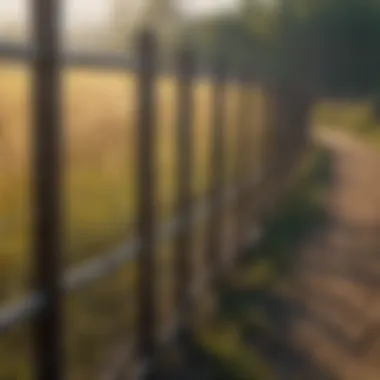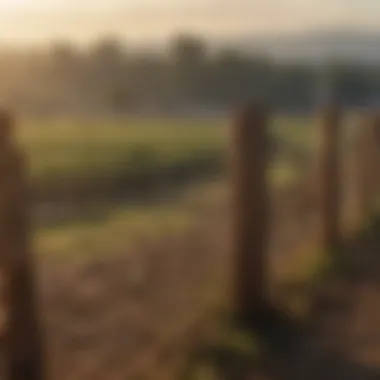Stock Fencing Supplier: A Guide to Agricultural Solutions


Intro
In the domain of agriculture, fencing serves as a critical barrier, providing safety and security for livestock, crops, and property. The role of stock fencing suppliers becomes vital in this context. These suppliers not only provide the fencing materials but also offer expertise in selecting the appropriate types of fencing for different agricultural needs. As farming practices evolve, so too do the innovations in fencing technology, making it essential for farmers and agricultural enthusiasts to stay informed about their options and consider several factors when selecting a stock fencing supplier.
Key Concepts and Terminology
Understanding some basic concepts related to stock fencing can significantly aid farmers in making informed decisions. Here are some fundamental terms:
- Stock Fencing: This refers to any type of fencing used to contain or manage livestock. It's designed to keep animals in a designated area while preventing unauthorized access.
- Materials: Common materials used in stock fencing include wood, wire, plastic, and metal. The choice of material impacts durability, maintenance requirements, and cost.
- Design Types: Various styles exist, such as barbed wire fencing, electric fencing, and post-and-rail fencing, each serving different purposes and offering specific advantages.
Basic Definitions
Stock fencing involves the selection of the right combination of materials and design tailored to farming needs. Each type of fencing has particular properties that influence its effectiveness. For instance, barbed wire is effective for containing livestock but can be hazardous, while wooden post-and-rail fencing offers a balance of safety and aesthetics.
Historical Context
Historically, the evolution of fencing can be traced back to early agriculture. The need to protect crops and livestock from predators and to delineate property lines has always been prevalent. Over centuries, advancements in materials and methods have transformed stock fencing solutions, allowing for improved safety and efficiency in agricultural practices.
Recent Innovations and Trends
As technology progresses, fencing solutions reflect greater innovation. Farmers should remain aware of these trends to ensure they invest in modern solutions that enhance their operational efficiency.
Technological Advancements
Recent years have seen significant advancements in fencing technologies. For example, electric fencing has advanced, offering remote monitoring and control features. Smart fencing solutions now integrate IoT technology, allowing farmers to monitor their livestock and obtain alerts directly to their smartphones.
Sustainable Practices
Sustainability has become a key consideration in modern farming. Many suppliers are moving towards environmentally friendly materials such as recycled plastics and sustainable wood sources. These practices not only help reduce environmental impact but also cater to a growing consumer demand for sustainability in agriculture.
Practical Applications and Techniques
Understanding how to apply fencing solutions effectively can greatly impact farming success.
Step-by-step Guides
When selecting fencing solutions:
- Assess Your Land: Understanding the topography and layout of your land will help in choosing the right type of fencing.
- Determine Livestock Needs: Different animals may require distinct types of fencing for containment.
- Budget Accordingly: Costs can vary significantly based on materials and design. It's important to factor in installation and maintenance costs.
Case Studies
Several farms have successfully implemented new fencing technologies. For example, a dairy farm in Wisconsin adopted electric fencing with remote monitoring, which allowed them to manage their cattle more efficiently. This led to improved pasture management and reduced manpower requirements.
"Investing in technology not only improves efficiency but also enhances the overall health of your livestock and land."
By equipping themselves with the right knowledge and understanding modern innovations, farmers can optimize their fencing solutions for both productivity and sustainability.
Understanding Stock Fencing
Understanding stock fencing is crucial for farmers and agricultural enthusiasts. The right fencing solution enables effective management of livestock and crops. It ensures animals remain within designated areas while protecting them from predators. By knowing what stock fencing entails, stakeholders can better assess their needs and choices.
Definition of Stock Fencing
Stock fencing refers to a barrier designed to confine livestock within a specific area. This type of fencing can vary in design and materials, depending on the needs it serves. Common materials used include wire, wood, and sometimes even electric components. The goal is to provide a safe, reliable, and effective method to manage animals on farms.
Purpose of Stock Fencing in Agriculture


The primary purpose of stock fencing is to protect livestock and crops. It keeps animals contained, preventing them from wandering into potentially harmful areas. Fencing also helps keep out unwanted animals, such as predators that could harm livestock or damage crops. Furthermore, stock fencing aids in the organization of farm operations. It allows farmers to manage grazing patterns and rotate livestock, promoting healthier pastures and better animal welfare.
Common Types of Stock Fencing
There are various types of stock fencing, each suited for different kinds of livestock and farming practices. Some common types include:
- Barbed Wire Fencing: Often used for cattle and larger animals. Its sharp edges deter animals from pushing through.
- Electric Fencing: Provides a mild electrical shock to animals, keeping them within boundaries. It is efficient for various livestock, especially in rotational grazing systems.
- Wooden Post and Rail Fencing: Commonly used in horse farming. It is sturdy and visually appealing but can be more expensive.
- Wire Fencing: A versatile option that can be used for different animals. It may come in various forms such as chain link or woven wire.
Each type has unique benefits and drawbacks. Farmers must consider cost, durability, and the specific livestock being managed to choose the most suitable option.
The Role of Stock Fencing Suppliers
Stock fencing suppliers play a vital role in the agricultural landscape. Their contribution goes beyond merely selling fencing materials. They are crucial in ensuring that farmers have access to the right products that help in managing livestock and protecting crops. Quality fencing is necessary to create secure enclosures that prevent animals from straying and protect them from predators. Thus, understanding the role of stock fencing suppliers can significantly impact operational efficiency on farms.
What Defines a Good Stock Fencing Supplier
A good stock fencing supplier is characterized by several key traits. Firstly, product quality is paramount. Durability and reliability are essential factors as fencing is exposed to harsh weather conditions and physical strain from livestock. A supplier should offer robust products made from materials like treated wood, high-quality wire, or composite materials that withstand wear.
Secondly, variety in the product range is important. Different farms have unique requirements based on geography, climate, and the type of livestock or crops. Suppliers who provide customized fencing solutions can greatly aid farmers in addressing specific needs.
Lastly, a solid reputation in the industry reflects the supplier's commitment to meeting customer needs and providing effective solutions. Positive reviews from other farmers often indicate a supplier's reliability and service quality.
Evaluating Supplier Reliability
Evaluating the reliability of a stock fencing supplier involves a comprehensive approach. Research is a crucial step. This includes checking online reviews, seeking testimonials from other farmers, and engaging with local farming communities. Consistent positive feedback from diverse sources can indicate a dependable supplier.
Certifications and compliance with industry standards also matter. A reputable supplier should possess the necessary accreditations, which ensure their products meet health and safety guidelines. Moreover, experience in the field enhances a supplier's credibility. Suppliers with years of expertise usually have a better understanding of the agricultural landscape and can anticipate potential customer needs more accurately.
Importance of Customer Support
Customer support is another significant aspect when considering a stock fencing supplier. The ability to provide timely assistance can make a difference, especially during the installation process or when facing unexpected challenges. A responsive support system can guide farmers in choosing the right fencing solutions for their specific situations.
Furthermore, many suppliers offer post-purchase support, including advice on maintenance and repair of fencing. This ongoing relationship can be vital for ensuring the longevity of fencing materials and overall farm productivity. A reliable supplier actively engages with their customers long after the purchase, reinforcing their commitment to high-quality service.
"Selecting the right stock fencing supplier can mean the difference between a secure farm and one prone to livestock losses."
Key Considerations When Choosing a Supplier
When engaging with stock fencing suppliers, several key considerations play a pivotal role in making the right choice. Unlike purchasing everyday items, selecting a fencing supplier can significantly affect agricultural productivity and livestock safety. Therefore, careful deliberation is necessary to ensure that the chosen supplier meets the specific needs of your operation.
Material Quality and Specifications
The foundation of effective stock fencing begins with material quality. High-quality materials lead to durable fences, which ultimately reduce the need for frequent repairs or replacements. Common materials include high-tensile wire, wood, and vinyl, each having its own merits.
- High-Tensile Wire: Known for its durability and strength, it's ideal for larger livestock and provides resistance against weather elements.
- Wood: Popular for its aesthetic appeal, wooden fences often require regular maintenance but can last for years when treated properly.
- Vinyl: This material is virtually maintenance-free and resistant to rot and rust but may not be as strong as other options.
Additionally, understanding the specifications of each material type is essential. Check the gauge of the wire or the treatment method used for wood. These specifications will provide insights into how well the fencing will perform.
Pricing and Cost-Effectiveness
Cost is often a deciding factor in choosing a supplier. However, it is crucial to look beyond just the upfront price. Cost-effectiveness includes not only the initial expenditure but also long-term value. Consider the following when evaluating pricing:
- Total Cost of Ownership: Factor in potential maintenance, life expectancy of materials, and installation costs.
- Supplier Deals: Look for packages or bulk discounts that can reduce overall expenses.
- Warranty and Guarantees: A supplier that offers a warranty suggests confidence in their products.
By assessing these financial aspects, you can ensure that you choose a supplier whose pricing aligns with your financial capabilities while ensuring quality and durability.
Delivery and Installation Services
Another vital consideration is the availability of delivery and installation services. Many suppliers offer these as part of their package, which can provide significant convenience.


- Timely Delivery: Ensure that the supplier can meet your timeline requirements for delivery to avoid any delays in your fencing installation.
- Professional Installation: Some suppliers have skilled teams to install the fencing, which can save time and guarantee that the fence is correctly erected. Improper installation can lead to future issues, such as breaches or structural weaknesses.
Moreover, ask if the supplier provides after-sales support. Assistance in case of installations issues or warranty claims is a considerable advantage.
Choosing a stock fencing supplier requires careful attention to various factors that impact longevity, cost, and functionality of the fencing solution.
Innovations in Fencing Technology
In the evolving field of agriculture, innovations in fencing technology are pivotal. Modern stock fencing must adapt to the needs of today’s farmers. These innovations enhance functionality, sustainability, and resource management. Through smart solutions and sustainable materials, farmers can improve livestock management while minimizing costs.
Smart Fencing Solutions
Smart fencing solutions represent a significant advancement in agricultural technology. These systems integrate digital technology with traditional fencing. They allow farmers to monitor livestock movements in real-time through sensors and smart devices. Benefits include:
- Improved Monitoring: Farmers can track the location and health of their livestock remotely.
- Enhanced Security: Automated alerts for breaches in the fence help prevent theft and stray animals.
- Efficient Resource Management: These systems can track water and feed consumption, optimizing overall operations.
Implementing smart fencing requires an understanding of necessary technology. Farmers must evaluate their connectivity needs, as many solutions rely on stable internet access. While the initial investment may be higher, the long-term savings and efficiency gains often justify the cost.
Sustainable Fencing Materials
Sustainable fencing materials are becoming increasingly important in the agricultural landscape. As awareness of environmental issues grows, farmers are seeking options that reduce ecological impact. Eco-friendly materials contribute to sustainability in several ways:
- Minimized Waste: Using recycled materials reduces the demand for new resources and minimizes waste.
- Durability: Many sustainable options, such as bamboo and recycled plastics, have longer life spans, which reduces the need for frequent replacements.
- Reduced Carbon Footprint: Sustainable materials often have a lower carbon footprint compared to traditional materials.
Choosing sustainable materials involves careful consideration of the properties and benefits of each type. Farmers should look for certifications and test results to ensure that the materials perform well under local conditions. This commitment to sustainability can also improve a farm's image and attract customers who value environmentally responsible practices.
Investing in innovations not only facilitates better livestock management. They can also prioritize farming practices that are socially and environmentally responsible.
Major Suppliers in the Market
The significance of exploring major suppliers in the agricultural fencing market is multifaceted. Understanding the competitive landscape allows farmers and landowners to make informed decisions that directly affect their operations. Established brands often provide a sense of reliability and quality assurance. However, emerging suppliers also present fresh innovations and alternatives that can often meet the specific needs of various farming scenarios.
Established Brands
Established brands in stock fencing supply have maintained a significant presence for several years, if not decades. Companies like Red Brand, Bekaert, and Tarter Farm and Ranch Equipment are recognized for their extensive product lines and high standards of quality. These brands often invest in research and development, ensuring that their fencing solutions meet current agricultural demands and environmental concerns.
When considering established brands, the following factors are often prioritized:
- Reputation: Long-standing suppliers tend to have proven track records in durability and effectiveness.
- Product Variety: They usually offer a wide range of options, allowing customers to select fencing that fits their specific requirements.
- Support Services: Established suppliers often have dedicated customer support and after-sales services, which can be invaluable for farmers.
- Warranty Offerings: Many recognized brands provide warranties, indicating confidence in their products.
Emerging Suppliers
While established brands offer security and reliability, emerging suppliers can provide innovative solutions that challenge traditional fencing methods. Suppliers like Farm & Ranch Depot and Ranch Fencing Inc. are newer entrants that emphasize sustainable materials and smart technology. These companies often cater to niche markets, offering tailored fencing solutions that might not be available from bigger brands.
Benefits of considering emerging suppliers include:
- Innovation: New suppliers often lead in implementing technology and sustainable practices, such as solar-powered fencing systems and eco-friendly materials.
- Cost-Effectiveness: They may offer more competitive pricing due to lower overhead costs and a desire to attract market share.
- Personalized Service: Smaller companies can provide more customized solutions and may offer a more personal experience when dealing with customers.
Case Studies: Successful Implementation of Stock Fencing
Case studies serve as a valuable resource for understanding the practical application of stock fencing solutions in agriculture. They highlight real-world examples where fencing has been successfully implemented, offering insights into the effectiveness, challenges, and benefits of various systems. Through these narratives, farmers can learn about innovative approaches and adapt best practices to their unique situations.
One significant aspect of these case studies is the emphasis on specific outcomes achieved by farmers after implementing stock fencing. This includes improved livestock management, reduced losses from predators, and enhanced land use efficiency. Such results demonstrate the potential transformation that well-constructed fencing can bring to agricultural enterprises.
Moreover, studying different case analyses allows farmers to see how various types of fencing materials and designs have functioned in diverse conditions. By examining these instances, they can make more informed decisions about which fencing solutions best suit their needs, taking into consideration aspects like durability, climate conditions, and the specific agricultural practices they employ.
"Implementing stock fencing was one of the best decisions I made for my farm. It reduced the problems with livestock wandering off and improved overall organization." - A satisfied farmer.


Farmers' Testimonials
Farmers' testimonials provide direct insights from those who have implemented stock fencing solutions. These personal accounts highlight the practical benefits experienced by individuals in the field. For instance, many farmers report significant improvements in livestock control. The right fencing not only prevents animals from straying but also minimizes stress among livestock, as they feel secure within a defined area. Testimonials often touch upon several key points:
- Reduction of livestock loss: Farmers can cite specific instances where the fencing protected their animals from wandering off or falling prey to predators.
- Operational Efficiency: Improved management of pasture areas leads to better grazing patterns, which are crucial for maintaining soil health and maximizing yield.
- Cost-Effectiveness: A number of farmers share how a good fencing solution has resulted in long-term savings by reducing labor costs and animal losses.
In essence, testimonials act as a validation of the investment in stock fencing. They reveal the personal experiences of farmers, further emphasizing the practicality and necessity of proper fencing in today's agricultural landscape.
Comparative Analysis of Different Suppliers
A comparative analysis of different fencing suppliers highlights the diverse solutions available in the market and their respective strengths and weaknesses. Such analysis is critical for farmers seeking to invest in stock fencing solutions. By evaluating various suppliers, farmers can identify who meets their specific needs in terms of quality, pricing, and customer service.
Key factors to consider in the comparison include:
- Material Quality: Different suppliers may offer varying grades of materials. A robust analysis can guide selection based on durability and maintenance.
- Pricing Structure: Understanding the cost of fencing solutions across different suppliers helps in making a budget-conscious decision while not compromising on quality.
- Customer Support: A supplier's reliability often reflects on their customer support. An analysis will reveal which suppliers provide better installation services, warranties, and ongoing support.
Such detailed comparisons empower farmers with the information necessary to make educated choices about which stock fencing supplier is right for them, ultimately leading to more successful and sustainable agricultural practices.
Best Practices for Stock Fencing Maintenance
Maintaining stock fencing is critical for ensuring its longevity and effectiveness. Proper maintenance not only safeguards the integrity of the fencing itself but also plays an essential role in livestock safety and management. When farm owners prioritize good maintenance practices, they benefit from reduced repair costs and enhanced durability of their fencing solutions.
Regular Inspection and Repairs
Frequent inspection of stock fencing is paramount. Conduct visual checks at least twice a year, or more often if the environment is harsh. Look for signs of wear, such as rust, rot, or loose wires. This can help identify issues early before they escalate into more significant problems. A well-maintained fence can prevent animals from straying and protect crops from being damaged.
If issues are detected, immediate repairs are necessary. Common repairs might include:
- Replacing damaged posts
- Tightening loose wires
- Replacing broken panels or barbed wire
By addressing these concerns promptly, the fencing can maintain its strength and functionality. This proactive approach reduces long-term costs and maintains peace of mind for the farmer.
Preventive Measures to Extend Fencing Life
Preventive maintenance is an effective strategy to prolong the lifespan of stock fencing. Here are some essential steps:
- Apply Protectives: Use coatings or treatments designed to protect against weather conditions. These protectives can significantly enhance durability.
- Proper Installation: Make sure the fencing is installed correctly. Poor installation can lead to early wire snapping or post failure.
- Manage Vegetation Growth: Regularly trim back any overgrown vegetation nearby the fence. This keeps the fencing visible and reduces the risk of rust and decay caused by contact with plants.
- Clear Debris: Keep the area around the fencing clear of debris that could cause damage during storms or with animal contact.
Implementing these preventive measures serves not only to extend the life of the fencing but also ensures the system functions effectively over time.
Tip: Many suppliers offer maintenance plans and guidance. Engaging with them can provide invaluable insights and resources for keeping your fencing in top condition.
The Future of Stock Fencing in Agriculture
The landscape of stock fencing is evolving due to various factors. Understanding the future of stock fencing in agriculture is crucial for farmers and suppliers alike. With the increasing pressures of modernization, sustainability, and technological advancements, knowing what lies ahead can influence important purchasing decisions.
Trends in Agricultural Fencing
Current trends indicate a shift towards environmentally sustainable materials. Farmers are becoming more conscious of their ecological footprint. Consequently, materials like recycled plastics and treated wood are gaining popularity. These materials not only have a reduced environmental impact but also offer durability and resilience against weather conditions.
- Smart Fencing Solutions: The integration of smart technology is another significant trend. Systems equipped with sensors and monitoring capabilities allow farmers to manage their fencing remotely. This can help in monitoring livestock movements and preventing potential breaches, which is crucial for farm security.
- Modular and Flexible Designs: Additionally, modular fencing systems allow for easy reconfiguration according to changing farm needs. This flexibility can adapt to different types of livestock or changing agricultural practices.
Despite these innovations, traditional fencing solutions will not disappear. They will evolve, incorporating modern enhancements while maintaining reliability.
Impacts of Regulatory Changes
Regulatory changes can significantly affect the stock fencing market. Governments often introduce new regulations aimed at improving animal welfare and environmental standards. Compliance with these regulations means farmers may need to upgrade their fencing systems.
- Animal Welfare Regulations: Stricter animal welfare laws can necessitate additional fencing requirements. This includes better containment systems to prevent livestock from wandering. Failing to comply can result in penalties or loss of funding.
- Environmental Legislation: Environmental regulations can also dictate the materials that can be used in fencing. For example, guidelines might limit the use of treated wood due to chemical leaching concerns. Farmers will then need to explore alternative, eco-friendly materials.
Farmers should stay informed about potential regulatory changes. Engaging with suppliers who understand these regulations ensures compliance and enhances the overall sustainability of farming practices.
"Staying ahead of regulatory changes can offer a competitive advantage in the agricultural market."
In summary, the future of stock fencing in agriculture will be shaped by trends towards sustainable solutions and the impacts of relevant regulations. Staying informed is essential for making strategic decisions, ensuring farmers can continue to operate efficiently within a changing landscape.















